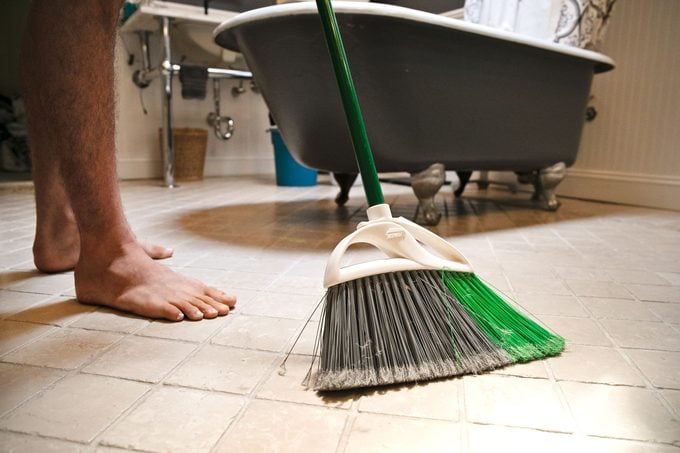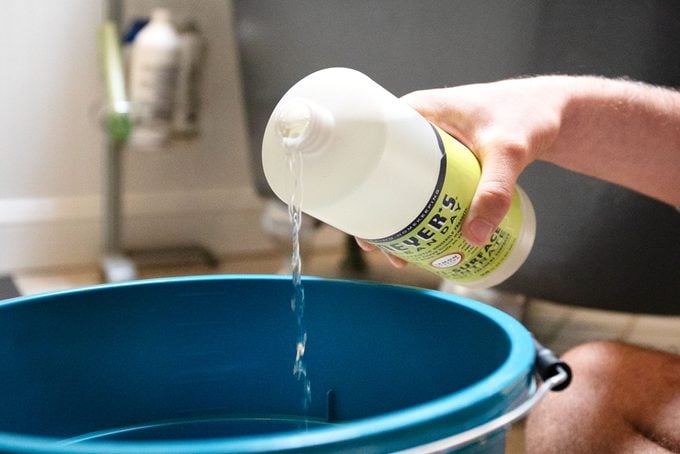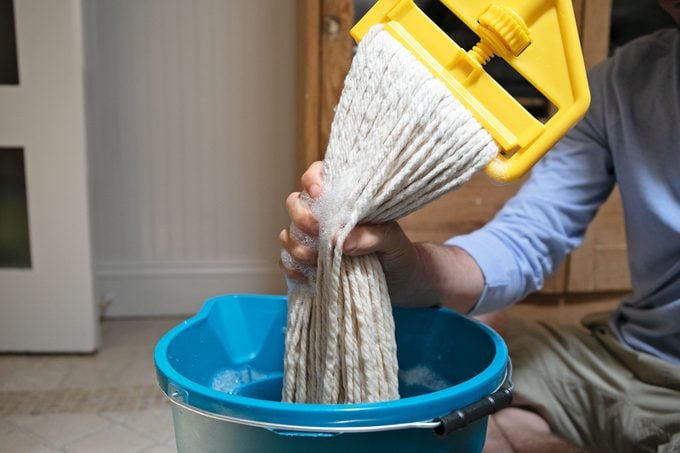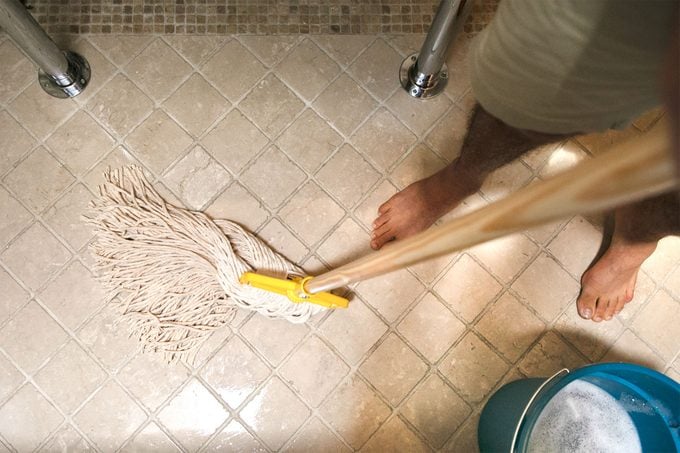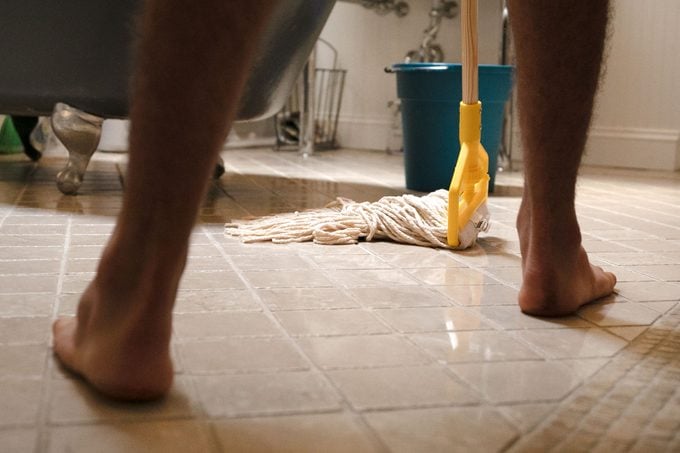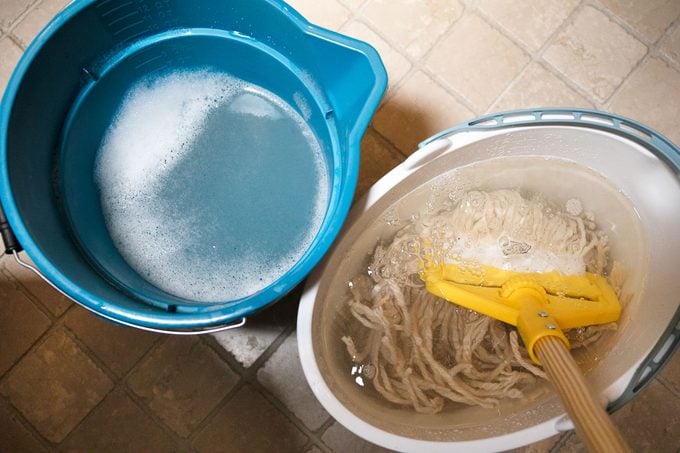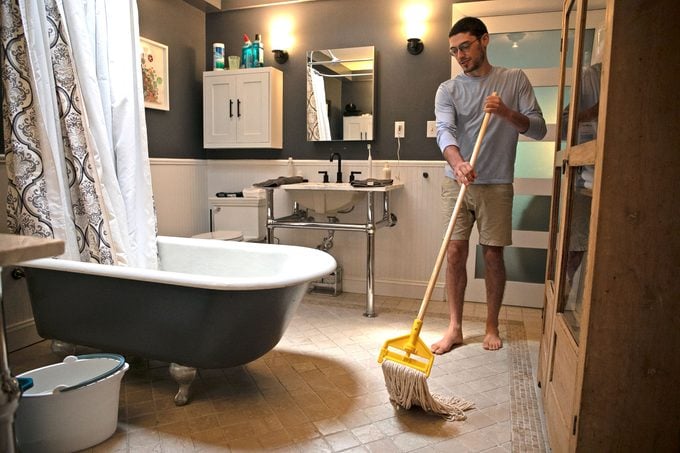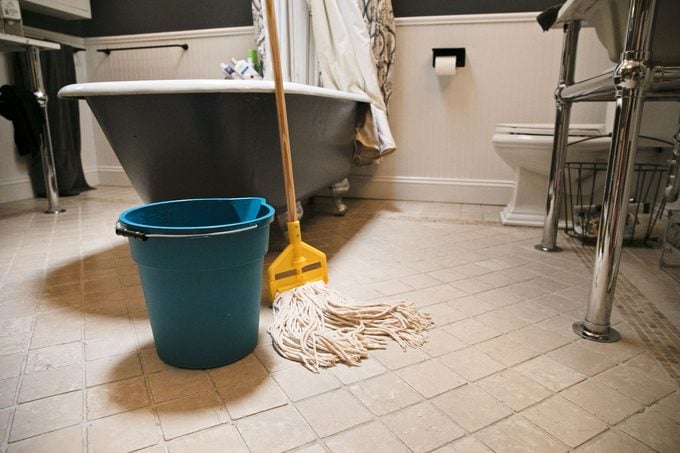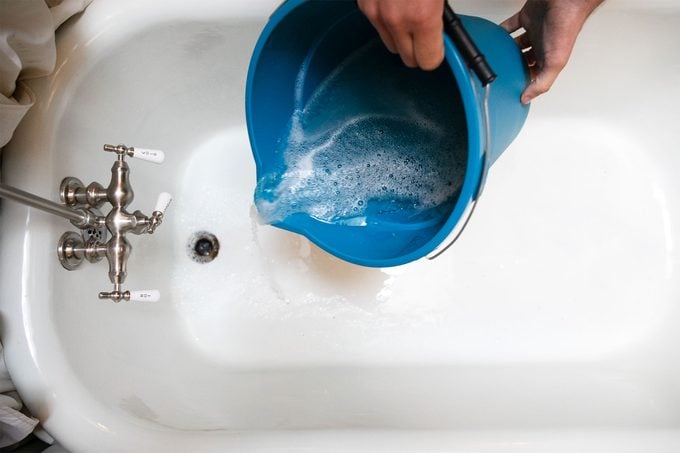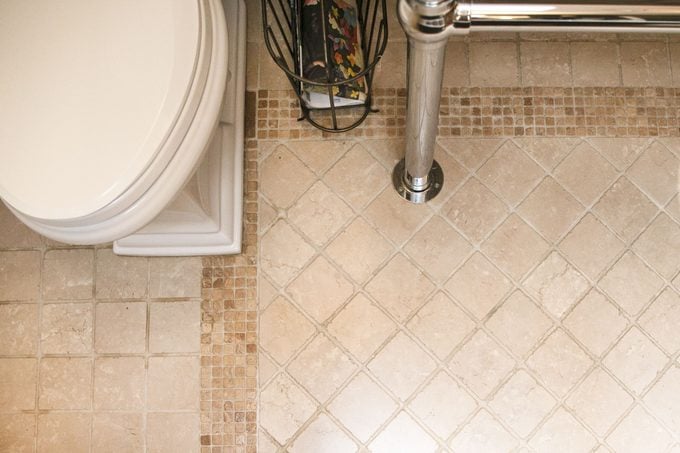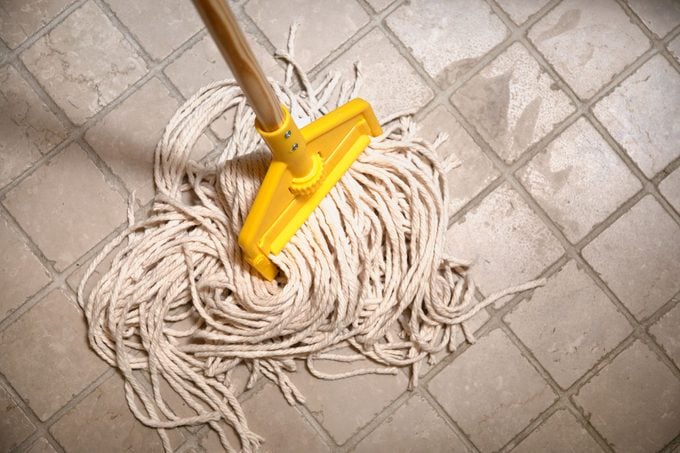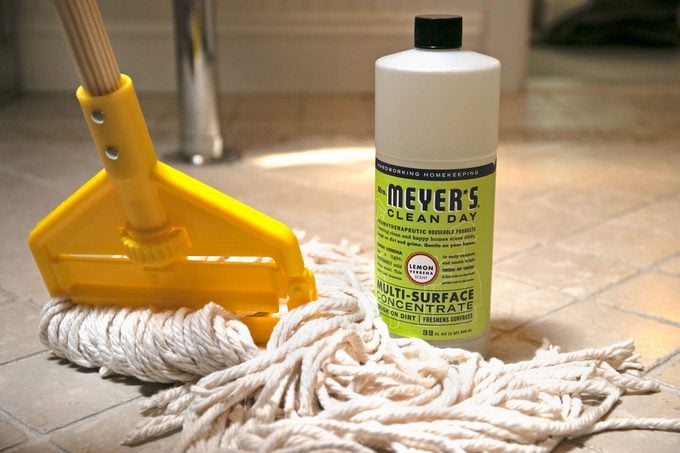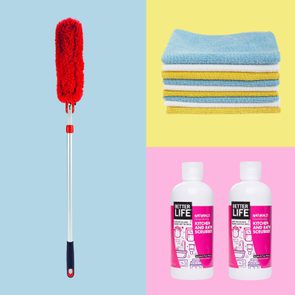How to Mop Floors the Right Way
Updated: May 24, 2024
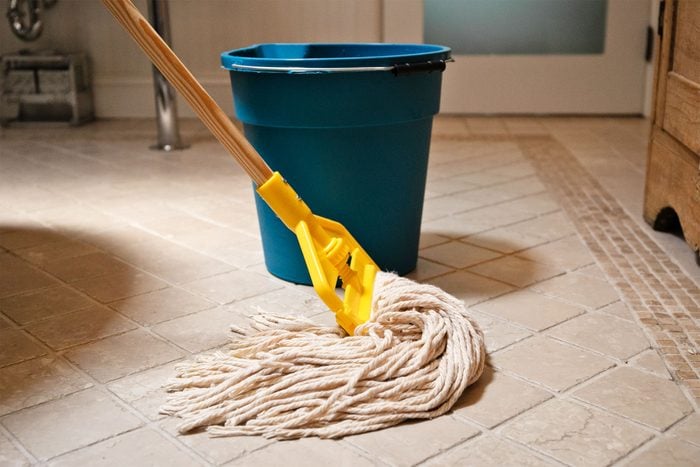
Yes, there is a right way and a wrong way to mop! These expert tips will protect your floors from accidental damage and get them truly clean.
If your floors are looking icky and sticky, it’s probably time to mop. But in order for your mopping to be effective, knowing how to mop floors the right way is key—it’s not as simple as grabbing a mop and bucket! Reader’s Digest spoke with two experts who know how to clean everything to get their advice: Jodie Hamilton, a certified cleaning expert at Amazing Services, and Natalie Barrett, a cleaning professional and supervisor at Nifty Cleaning Services.
So what do you need to know? For starters, how to prep your floor for mopping, what cleaning agents to use and what type of mop is best for your flooring. That’s right—there’s a difference between how to clean vinyl floors and how to clean laminate.
We told you there was a lot to consider! But we’re about to make your life a lot easier with these step-by-step instructions. We’ve laid it all out—from the expert-recommended ways to mop your floors to the best cleaning solutions—so your floors will be sparkling in no time.
Get Reader’s Digest’s Read Up newsletter for more cleaning, humor, travel, tech and fun facts all week long.
About the experts
|
Supplies you’ll need
- Broom or vacuum
- Cleaning solution
- Mop
- Two buckets, one with a wringer
- Rubber gloves
- Floor squeegee (optional)
Step 1: Sweep and/or vacuum the floor
Whatever you do, don’t skip this step! The experts say it’s essential. “You avoid making muddy messes or getting sticky floors by removing the excess dirt from the surface before you start mopping,” Hamilton says.
The best vacuums will suck dirt right up, so grab one before you mop. Otherwise, you’ll only be smearing the grime around. Plus, if you notice any stubborn stains or food spills, this is the time to grab a soft sponge to remove them before beginning the mopping process, adds Barrett.
So when should you pull out the broom, the vacuum or both? “It’s best to vacuum if you only have hairs or dust on the surface,” says Barrett, “while sweeping is a better option if you’re trying to get rid of larger pieces of dirt or other products that may be difficult for your vacuum cleaner to tackle.”
Look for a vacuum that has soft bristles (so as not to scratch your floors) and strong suctioning power that can pull dirt out of any nooks or crevices.
Step 2: Mix the cleaning agent with hot water in a bucket
Once the floors have been swept and/or vacuumed, it’s time to grab your bucket. Mix the cleaning product with hot water in a bucket as instructed on the label.
Look for a bucket that can hold at least five gallons (any smaller and it’ll be harder to dunk your mop without making a mess), has a built-in wringer if your mop doesn’t have one, and has wheels to make cleaning easier—otherwise, you’ll have to walk over newly washed floors to get to your bucket or lug it around with you as you mop.
Hamilton adds: “If this is your first time using the selected product, make sure to carefully read the instructions and mix with water as advised. Failing to do this may give you a completely different result than the intended one.” For example, using too little water could leave behind a sticky residue that only attracts more gunk, whereas using too little will be ineffective.
Step 3: Wet the mop so it’s damp, not wet
“Dip the mop in the bucket and remove the excess water using a wringer or your hands—the mop should only be damp, not dripping,” Barrett says.
This is especially important when you’re dealing with wood floors. “Using a mop that is too wet and leaves water everywhere could harm your floors. Too much water on wood can cause the material to swell up, and it can result in blackened spots, water-stained areas, or warped or completely ruined wood.”
Tiles aren’t impervious to too much water, either. “Water can also push the tile to lift up or swell,” explains Barrett. “It can also be a cause of mold in the long term.” The same goes for laminate, which can bend and buckle if it’s doused with water. That’s why a mop and bucket combo with a built-in wringer is a good idea.
Step 4: Start mopping, making sure to use the correct motions
Depending on the type of mop you’ve chosen, you’ll need to make different movements when cleaning. String mops require a swishing motion, while foam mops require light pressure in one direction. The rationale? “A swishing motion for string mops will prevent the dirt from getting lifted up, while a pushing motion for a foam mop helps you lift the dirt up, which is what you want to do,” Barrett explains.
Step 5: Move backward with each mop stroke
Perhaps the single best piece of advice for how to mop floors correctly is this: Move backward as you mop. “Start mopping moving backward, and avoid stepping on the wet area, as this will leave behind foot traces,” Barrett says. Moving backward gives the wet areas time to dry before you walk over them again.
She also suggests trying to mop in straight lines. It’ll make you less likely to miss spots and decrease the chances that you’ll step somewhere that’s been freshly cleaned.
Step 6: Rinse the mop as you go
Rinsing your mop regularly will keep you from pushing dirty water around, so you’ll need a second bucket of plain water to dip your mop into after you finish each section. “Rinse the mop after you’ve finished a portion of the floor,” Barrett says, “then dip it in the bucket with the cleaning solution again.” Do this about every 20 to 50 square feet, and don’t forget to wring it out so the mop is damp (not wet!) before resuming.
You can use a simple bucket for this part, since it’s not required for you to wring your mop out—though using a second five-gallon bucket with a wringer will make you less likely to leave drips as you move your mop from the bucket of water into the bucket full of cleaning solution.
Step 7: Keep going until you’ve mopped the entire floor
Working your way across the entire floor, walking backward so as not to leave footprints on any wet areas, continue until every area has been mopped. One pass should be good enough, but if the floor was especially dirty, you can repeat the process until you’re satisfied with the results.
Step 8: Let the floor dry
Now, your work is done. Just rinse the mop again, and leave the floor to dry. Try to avoid walking on it for 15 to 20 minutes, or until it’s dry to the touch. If you do have to walk on it, wear clean socks. You can also help your floors dry faster by using a floor squeegee.
Step 9: Clean your mop and bucket
One final tip: “A lot of people forget to clean the bucket and mop after use and leave them dirty for the next time they’re ready to use them—that’s a bad idea,” Hamilton says. Dirt and grime can dry and get stuck on the mop, making your mopping less effective the next time around.
To clean your mop and bucket after use, Barrett suggests putting on a pair of cleaning gloves, which will keep you protected from bacteria, and thoroughly rinsing the mop and bucket with warm water in your sink or tub. Then, fill the bucket with water and bleach, using a solution of one gallon of water and three-quarters cup of bleach. Put the mop in the bucket, and let it sit for about 10 to 15 minutes.
“Just be careful if you’re using ammonia-based cleaning products,” Barrett cautions, “as ammonia and bleach create a dangerous and toxic gas.” In that case, you can substitute the bleach with vinegar. Finish by washing the bucket with a sponge and rinsing the mop thoroughly. Then give yourself a pat on the back for a job well done.
FAQs
How often should you mop?
A good rule of thumb for most areas is to mop every two to three weeks. Areas with particularly high traffic should be mopped once a week, and areas that are used very infrequently are okay to mop once a month.
What happens if you use the wrong products?
Using the wrong type of mop for your floors won’t ruin them, but it won’t clean them either—it will only push the dirt around.
Using the wrong cleaning solution, however, can cause a bit more of a mess. For example, if you use a solution that’s not suitable for hardwood floors, you could strip the finish, or if you use a waxy cleaner on tile, it could leave your floors feeling slippery or looking hazy.
What type of mop is best?
If you thought that picking a mop was merely a matter of personal preference, think again. “The choice of the mop depends on the type of floor you have,” says Barrett. “For example, ceramic tile floors call for a strip mop, while a smooth floor (such as hardwood) calls for a sponge mop.”
The reason? “If you don’t use a strip mop on ceramic tiles but instead use a sponge mop, you risk pushing the dirt from the tiles into the grout. A smooth or hardwood floor doesn’t have any grout or openings—this is why a sponge mop is best.”
What type of cleaning solution is best?
It depends on your floors. Always check the label of your cleaning product to see what surfaces it’s recommended for before getting started.
“Some cleaning agents will leave behind oily stains if they’re not properly chosen,” Hamilton says. “For example, if you’re cleaning a wood surface, it’s not advisable to use cleaning detergents with ingredients like ammonia, vinegar and oils. Stone, on the other hand, does not go well with lemon or vinegar-based cleaners.”
For hardwoods, Barrett suggests using Bona Hardwood Cleaner because “it’s delicate and not too strong but at the same time cleans perfectly and leaves a shine behind.” It’s also pH balanced and doesn’t leave behind any sticky messes. For a DIY approach, Hamilton suggests a combo of lemon juice, olive oil and hot water.
For ceramic tile, vinyl and other non-porous surfaces, Barrett recommends Mrs. Meyer’s Clean Day; this concentrated solution works on everything from tile to marble to linoleum. For homemade cleaning options, you can mix borax with water, or mix two gallons of hot water with two tablespoons of castile soap and a few drops of your favorite essential oil.
Why trust us
At Reader’s Digest, we’re committed to producing high-quality content by writers with expertise and experience in their field in consultation with relevant, qualified experts. For this piece, Maryn Liles tapped her experience as a home and lifestyle writer, and then Ann Russell, TikTok’s “cleaning auntie” with more than 2 million followers and the author of How to Clean Everything, gave it a rigorous review to ensure that all information is accurate and offers the best possible advice to readers. We verify all facts and data, back them with credible sourcing and revisit them over time to ensure they remain accurate and up to date. Read more about our team, our contributors and our editorial policies.
Sources:
- Jodie Hamilton, a certified cleaning expert at Amazing Services; interviewed June 2021
- Natalie Barrett, a cleaning professional and quality supervisor at Nifty Cleaning Services; interviewed June 2021





















